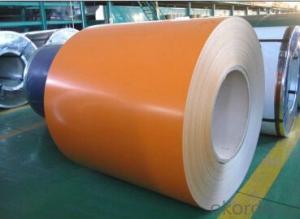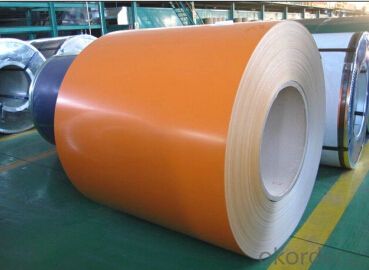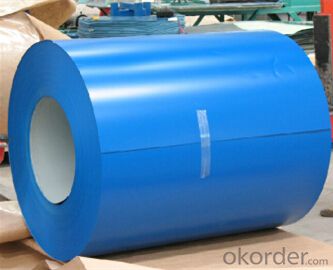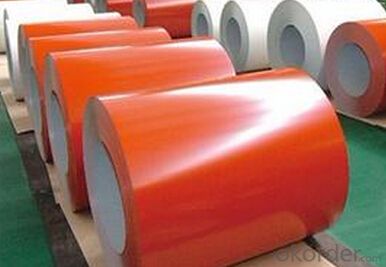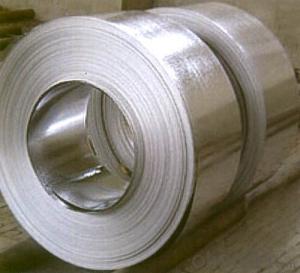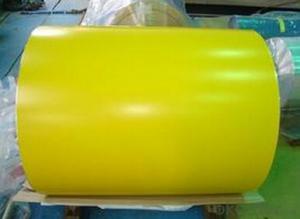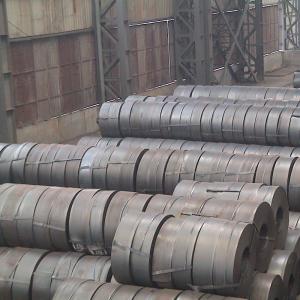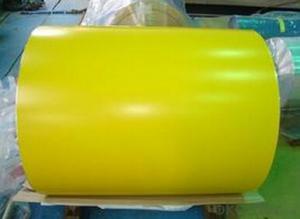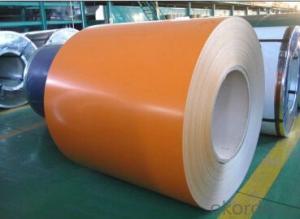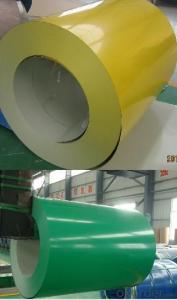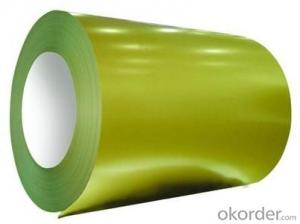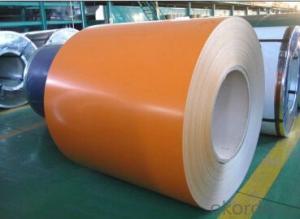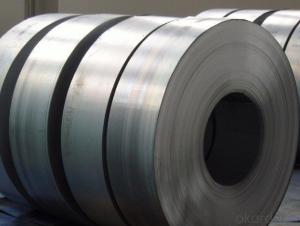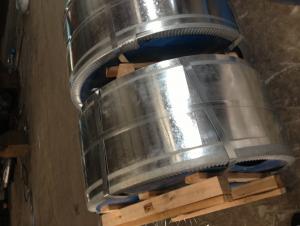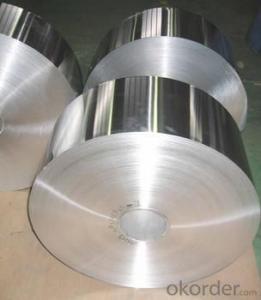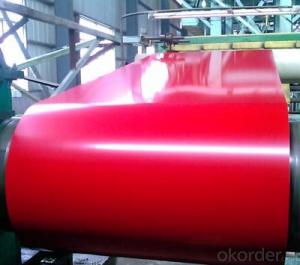PPGI Prepainted Galvanized steel Coil ASTM 615-009
- Loading Port:
- Tianjin
- Payment Terms:
- TT OR LC
- Min Order Qty:
- 22 kg/m²
- Supply Capability:
- 11 kg/m²/month
OKorder Service Pledge
OKorder Financial Service
You Might Also Like
1.Structure of Prepainted Galvanized steel Coil :
With Gi as base metal,after pretreatmet (degrease and chemical treatment) and liquid dope with several Layers of color,then after firing and cooling,finally the plate steel is called pre-painted galvanized steel ( PPGI) .Pre-painted galvanized steel is good capable of decoration ,molding,corrosion resistance lowering the cost of production and increasing the quality of the metal. Today, steel is one of the most common materials in the world, with more than 1.3 billion tons produced annually. It is a major component in buildings, infrastructure, tools, ships, automobiles, machines, appliances, and weapons. Modern steel is generally identified by various grades defined by assorted standards organizations.
2.Main Features of Prepainted Galvanized steel Coil:
• Excellent process capability
• Smooth and flat surface
• Workability, durability
• Excellent heat resistance performance
• High strength
• Good formability
• Good visual effect
3.Prepainted Galvanized steel Coil Images
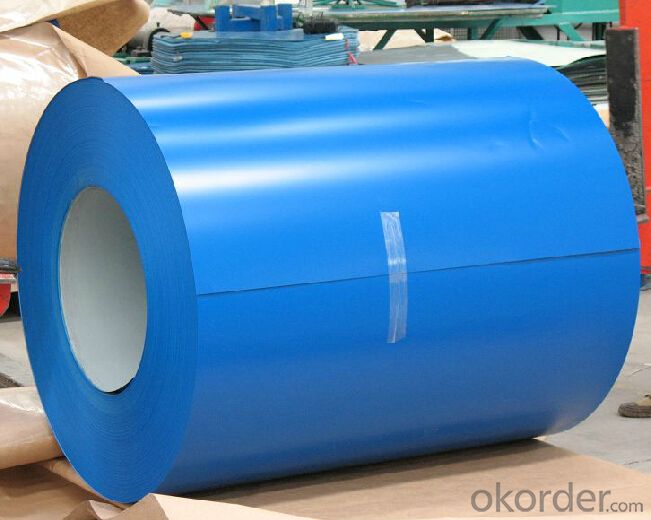
4.Prepainted Galvanized steel Coil Specification
Community portal – Bulletin board, projects, resources and activities covering a wide range of Wikipedia areas.
Help desk – Ask questions about using Wikipedia.
Local embassy – For Wikipedia-related communication in languages other than English.
Reference desk – Serving as virtual librarians, Wikipedia volunteers tackle your questions on a wide range of subjects.
Site news – Announcements, updates, articles and press releases on Wikipedia and the Wikimedia Foundation.
Village pump – For discussions about Wikipedia itself, including areas for technical issues and policies.
C | Si | Mn | Cr | Ni | P | S |
0.150 | 0.476 | 11.231 | 12.50 | 0.900 | 0.039 | 0.010
|
5.FAQ of Prepainted Galvanized steel Coi
We have organized several common questions for our clients,may help you sincerely:
1.How do you control your quality
We have established the international advanced quality management system,every link from raw material to final product we have strict quality test;We resolutely put an end to unqualified products flowing into the market. At the same time, we will provide necessary follow-up service assurance.
2.how long we will receive the goods ?
After receiving your deposit or workable lc ,our normal shipment date is 15-20days,and it takes around 28 days to reach your port of destination. But is up to different destination The bar-throated minla (Minla strigula) is a species of bird found in the montane forests of the Indian subcontinent and Southeast Asia.
3. what is your moq
Normally our moq is 25per size ,but it is up to different size
- Q: What are the different methods for plating steel strips?
- There are several different methods for plating steel strips, each with its advantages and limitations. Some common methods include: 1. Electroplating: This method involves immersing the steel strip in an electrolyte bath containing metal ions of the desired plating material. When an electric current is passed through the bath, the metal ions are attracted to the steel strip, forming a thin layer of the desired metal on its surface. Electroplating allows for precise control over the plating thickness and can be used to apply a wide range of metals, such as zinc, nickel, or chromium. 2. Hot-dip galvanizing: This process involves immersing the steel strip in a bath of molten zinc. The high temperature causes a metallurgical reaction between the steel and the zinc, resulting in the formation of a zinc-steel alloy coating. Hot-dip galvanizing provides excellent corrosion resistance and is commonly used for outdoor applications, such as in construction or automotive industries. 3. Electroless plating: In this method, a chemical deposition process is used to deposit a metal coating onto the steel strip without the need for an electric current. The process relies on a controlled chemical reaction between the steel surface and a plating solution. Electroless plating offers uniform coating thickness and can be applied to complex shapes, making it suitable for precision components or electronics. 4. Mechanical plating: This technique involves tumbling the steel strip with metal powder, glass beads, and a special chemical mixture in a rotating barrel. The centrifugal force generated during tumbling causes the metal powder to impact and adhere to the steel strip, creating a mechanical bond. Mechanical plating is commonly used for parts that require a thick, durable, and uniform coating, such as fasteners or hardware. 5. Thermal spraying: This method involves heating the plating material, typically in powder or wire form, and propelling it onto the steel strip using compressed air or a similar mechanism. The high-velocity impact of the sprayed particles results in a coating adhering to the steel surface. Thermal spraying is often used for applying materials with high melting points, such as ceramic or metallic coatings, to provide wear resistance or thermal insulation. It is important to consider the specific requirements of the application, such as corrosion resistance, durability, or aesthetic appeal, when selecting the appropriate plating method for steel strips.
- Q: What are the load-bearing capabilities of steel strips?
- Steel strips have high load-bearing capabilities due to their inherent strength and rigidity. The load-bearing capacity of steel strips depends on various factors such as the thickness, width, and grade of the steel, as well as the specific application and conditions in which it is used. Steel strips are commonly used in construction, automotive, and manufacturing industries where they provide excellent support and stability under heavy loads.
- Q: Can steel strips be formed into complex shapes?
- Various processes, including bending, rolling, stamping, and forming, enable steel strips to be transformed into intricate shapes. Steel, as a versatile material, can be manipulated to meet the specific requirements of different applications in terms of shape and size. Through the utilization of specialized machinery and tools, steel strips can be curved, twisted, and shaped into complex designs. These formed steel strips find extensive use in industries such as automotive, aerospace, construction, and manufacturing, where intricate shapes are frequently necessary for various components and structures. The ability of steel strips to assume complex shapes renders them an invaluable asset in contemporary engineering and design.
- Q: Can steel strips be used in the manufacturing of cutting tools?
- Yes, steel strips can be used in the manufacturing of cutting tools. Steel strips are often used as the base material for cutting tool blades due to their high strength, durability, and ability to hold a sharp edge. The steel strips can be hardened and tempered to achieve the desired hardness and toughness required for various cutting applications.
- Q: Can steel strips be used in the production of kitchen utensils?
- Yes, steel strips can be used in the production of kitchen utensils. Steel is a common material choice for utensils due to its strength, durability, and resistance to corrosion. Steel strips can be shaped and formed into various kitchen utensils like knives, spoons, forks, and spatulas, providing a reliable and long-lasting option for culinary purposes.
- Q: How are steel strips used in the production of metal fencing?
- The production of metal fencing relies heavily on steel strips, which serve as a vital component. Throughout the manufacturing process, these strips are utilized in various ways to construct sturdy and long-lasting fencing structures. A primary application of steel strips in metal fencing production is their use in forming the fence's framework or skeleton. These strips are often bent or welded together to create desired shapes, such as posts, rails, or panels. The strong and rigid nature of steel makes it an ideal material for providing structural integrity to the fence, ensuring its ability to withstand external forces and maintain its shape over time. Steel strips also play a crucial role in fabricating fencing components, including brackets, hinges, and fasteners. These strips are precisely cut and shaped to function as connectors, securely joining different parts of the fence together. The durability of steel guarantees that these components can endure the pressure and stress exerted on them during installation and throughout the fence's lifespan. Furthermore, steel strips are frequently employed for reinforcement purposes in metal fencing production. They can be strategically incorporated into the fence design to enhance its strength and resistance against bending or warping. This reinforcement ensures the overall stability of the fence, which is particularly important in high-security or heavy-duty fencing applications. Additionally, steel strips contribute significantly to the longevity of metal fencing. They are often coated or treated with protective materials, such as galvanization or powder coating, to prevent corrosion and rust formation. This protective layer not only enhances the fence's appearance but also extends its lifespan by shielding the steel strips from environmental elements and harsh weather conditions. In conclusion, steel strips are essential in metal fencing production for constructing the framework, fabricating components, reinforcing the structure, and ensuring longevity. Their strength, durability, and versatility make them an indispensable component in the manufacturing process, enhancing the overall quality and performance of metal fences.
- Q: What are the common surface defect inspection methods for steel strips?
- There are several common surface defect inspection methods that are widely used for steel strips. 1. Visual Inspection: This is the simplest and most basic method of surface defect inspection. It involves a trained inspector visually examining the steel strips for any visible defects such as scratches, dents, cracks, or discoloration. While this method is subjective and relies on the inspector's skills and experience, it can still be effective for identifying major defects. 2. Magnetic Particle Inspection (MPI): MPI is a non-destructive testing method that uses magnetic particles to detect surface defects in steel strips. The steel strip is magnetized, and magnetic particles are applied to the surface. Any defects, such as cracks or discontinuities, will cause the magnetic particles to gather at these locations, making them visible to the inspector. 3. Ultrasonic Testing (UT): UT is another non-destructive testing method commonly used for inspecting steel strips. It involves the use of high-frequency sound waves that are transmitted into the steel strip. Any defects or discontinuities in the material will cause the sound waves to bounce back, creating echoes that can be detected and analyzed to identify surface defects. 4. Eddy Current Testing (ECT): ECT is a non-destructive testing method that uses electromagnetic induction to detect surface defects in conductive materials like steel. A coil carrying an alternating current is placed near the surface of the steel strip, creating eddy currents in the material. Any defects or changes in the material's conductivity will cause a variation in the eddy currents, which can be detected and analyzed to identify surface defects. 5. X-ray Inspection: X-ray inspection is a method that uses X-rays to detect surface and internal defects in steel strips. X-rays can penetrate the material and create an image of its internal structure. This method is particularly useful for detecting internal defects such as voids, inclusions, or delaminations that may not be visible by visual inspection. These are some of the common surface defect inspection methods used for steel strips. The choice of method depends on factors such as the type and size of defects, the required sensitivity, and the cost-effectiveness of the inspection.
- Q: How are steel strips processed for surface deburring?
- Steel strips are typically processed for surface deburring using various methods such as abrasion, brushing, grinding, or chemical treatments. These processes help remove any sharp edges, burrs, or imperfections from the surface of the steel strips, resulting in a smooth and clean finish.
- Q: What are the sectors in which galvanized steel strips can be used?
- Same as steel plate, strip steel is divided into two kinds of ordinary strip steel and high quality strip steel according to the material used, and two kinds of hot-rolled strip steel and cold rolled strip steel according to processing method. Strip steel is widely used in the production of welded steel pipe, made of cold formed steel billet, manufacturing bicycle frame, rim, clamp, gasket, spring, saw blades, hardware and blades. The use of hot galvanized strip is naturally associated with the application of galvanized strip in construction, light industry, automobile, agriculture, animal husbandry, fishery and business. Now, with the improvement of various industries, electronics and other manufacturing processes, the application of materials is also more and more widespread.
- Q: How do steel strips perform in seismic conditions?
- Steel strips perform well in seismic conditions due to their high strength and ductility. They have the ability to absorb and dissipate seismic energy, reducing the impact of vibrations on structures. Additionally, steel strips can be easily incorporated into building designs to enhance their seismic resistance and ensure the safety of occupants during earthquakes.
Send your message to us
PPGI Prepainted Galvanized steel Coil ASTM 615-009
- Loading Port:
- Tianjin
- Payment Terms:
- TT OR LC
- Min Order Qty:
- 22 kg/m²
- Supply Capability:
- 11 kg/m²/month
OKorder Service Pledge
OKorder Financial Service
Similar products
Hot products
Hot Searches
Related keywords
